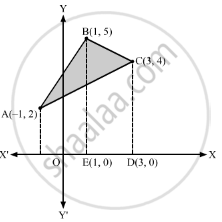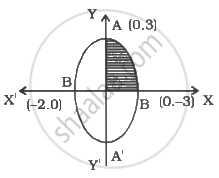Advertisements
Advertisements
Question
Using integration, find the area of the region bounded by the triangle whose vertices are (−1, 2), (1, 5) and (3, 4).
Solution
Let ABC be the triangle with vertices A(−1, 2), B(1, 5) and C(3, 4).

Equation of AB is \[y - 5 = \left( \frac{2 - 5}{- 1 - 1} \right)\left( x - 1 \right)\]
\[ \Rightarrow y - 5 = \frac{3}{2}\left( x - 1 \right)\]
\[ \Rightarrow y = \frac{3}{2}x + 5 - \frac{3}{2} = \frac{3x + 7}{2}\]
Equation of BC is \[y - 4 = \left( \frac{5 - 4}{1 - 3} \right)\left( x - 3 \right)\]
\[ \Rightarrow y - 4 = - \frac{1}{2}\left( x - 3 \right)\]
\[ \Rightarrow y = - \frac{1}{2}x + 4 + \frac{3}{2} = \frac{- x + 11}{2}\]
Equation of CA is \[y - 2 = \left( \frac{4 - 2}{3 + 1} \right)\left( x + 1 \right)\]
\[ \Rightarrow y - 2 = \frac{1}{2}\left( x + 1 \right)\]
\[ \Rightarrow y = \frac{1}{2}x + 2 + \frac{1}{2} = \frac{x + 5}{2}\]
∴ Required area = Area of the shaded region
= Area of the region ABEFA + Area of the region BCDEB − Area of the region ACDFA
\[= \int_{- 1}^1 y_{AB} dx + \int_1^3 y_{BC} dx - \int_{- 1}^3 y_{CA} dx\]
\[ = \int_{- 1}^1 \left( \frac{3x + 7}{2} \right)dx + \int_1^3 \left( \frac{- x + 11}{2} \right)dx - \int_{- 1}^3 \left( \frac{x + 5}{2} \right)dx\]
\[ = \left.\frac{1}{2} \times \frac{\left( 3x + 7 \right)^2}{2 \times 3}\right|_{- 1}^1 + \left.\frac{1}{2} \times \frac{\left( - x + 11 \right)^2}{2 \times \left( - 1 \right)}\right|_1^3 - \left.\frac{1}{2} \times \frac{\left( x + 5 \right)^2}{2}\right|_{- 1}^3 \]
\[ = \frac{1}{12}\left( 100 - 16 \right) - \frac{1}{4}\left( 64 - 100 \right) - \frac{1}{4}\left( 64 - 16 \right)\]
\[ = \frac{84}{12} + \frac{36}{4} - \frac{48}{4}\]
\[ = 7 + 9 - 12\]
\[ = 4\text{ square units }\]
APPEARS IN
RELATED QUESTIONS
Using integration, find the area bounded by the curve x2 = 4y and the line x = 4y − 2.
triangle bounded by the lines y = 0, y = x and x = 4 is revolved about the X-axis. Find the volume of the solid of revolution.
Using integration, find the area of the region bounded by the lines y = 2 + x, y = 2 – x and x = 2.
Draw a rough sketch to indicate the region bounded between the curve y2 = 4x and the line x = 3. Also, find the area of this region.
Make a rough sketch of the graph of the function y = 4 − x2, 0 ≤ x ≤ 2 and determine the area enclosed by the curve, the x-axis and the lines x = 0 and x = 2.
Sketch the region {(x, y) : 9x2 + 4y2 = 36} and find the area of the region enclosed by it, using integration.
Determine the area under the curve y = \[\sqrt{a^2 - x^2}\] included between the lines x = 0 and x = a.
Sketch the graph y = | x + 3 |. Evaluate \[\int\limits_{- 6}^0 \left| x + 3 \right| dx\]. What does this integral represent on the graph?
Find the area of the region bounded by the curve \[x = a t^2 , y = 2\text{ at }\]between the ordinates corresponding t = 1 and t = 2.
Find the area enclosed by the curve x = 3cost, y = 2sin t.
Find the area of the region bounded by x2 = 16y, y = 1, y = 4 and the y-axis in the first quadrant.
Find the area of the region between the circles x2 + y2 = 4 and (x − 2)2 + y2 = 4.
Find the area, lying above x-axis and included between the circle x2 + y2 = 8x and the parabola y2 = 4x.
Prove that the area common to the two parabolas y = 2x2 and y = x2 + 4 is \[\frac{32}{3}\] sq. units.
Find the area bounded by the parabola y = 2 − x2 and the straight line y + x = 0.
Find the area bounded by the curves x = y2 and x = 3 − 2y2.
The area bounded by y = 2 − x2 and x + y = 0 is _________ .
The area bounded by the curves y = sin x between the ordinates x = 0, x = π and the x-axis is _____________ .
The area of the region bounded by the parabola y = x2 + 1 and the straight line x + y = 3 is given by
The area of the region (in square units) bounded by the curve x2 = 4y, line x = 2 and x-axis is
Smaller area enclosed by the circle x2 + y2 = 4 and the line x + y = 2 is
Using the method of integration, find the area of the triangle ABC, coordinates of whose vertices area A(1, 2), B (2, 0) and C (4, 3).
Find the area of the region bound by the curves y = 6x – x2 and y = x2 – 2x
The area enclosed by the ellipse `x^2/"a"^2 + y^2/"b"^2` = 1 is equal to ______.
Sketch the region `{(x, 0) : y = sqrt(4 - x^2)}` and x-axis. Find the area of the region using integration.
Find the area of region bounded by the triangle whose vertices are (–1, 1), (0, 5) and (3, 2), using integration.
Find the area bounded by the curve y = 2cosx and the x-axis from x = 0 to x = 2π
The area of the region bounded by the line y = 4 and the curve y = x2 is ______.
Find the area of the region bounded by the ellipse `x^2/4 + y^2/9` = 1.
Make a rough sketch of the region {(x, y): 0 ≤ y ≤ x2, 0 ≤ y ≤ x, 0 ≤ x ≤ 2} and find the area of the region using integration.
Using integration, find the area of the region bounded by the curves x2 + y2 = 4, x = `sqrt(3)`y and x-axis lying in the first quadrant.
Let the curve y = y(x) be the solution of the differential equation, `("dy")/("d"x) = 2(x + 1)`. If the numerical value of area bounded by the curve y = y(x) and x-axis is `(4sqrt(8))/3`, then the value of y(1) is equal to ______.
The area (in sq.units) of the region A = {(x, y) ∈ R × R/0 ≤ x ≤ 3, 0 ≤ y ≤ 4, y ≤x2 + 3x} is ______.
Let f : [–2, 3] `rightarrow` [0, ∞) be a continuous function such that f(1 – x) = f(x) for all x ∈ [–2, 3]. If R1 is the numerical value of the area of the region bounded by y = f(x), x = –2, x = 3 and the axis of x and R2 = `int_-2^3 xf(x)dx`, then ______.
The area of the region bounded by the parabola (y – 2)2 = (x – 1), the tangent to it at the point whose ordinate is 3 and the x-axis is ______.
Sketch the region bounded by the lines 2x + y = 8, y = 2, y = 4 and the Y-axis. Hence, obtain its area using integration.
Using integration, find the area of the region bounded by the curve y2 = 4x and x2 = 4y.
Sketch the region enclosed bounded by the curve, y = x |x| and the ordinates x = −1 and x = 1.
